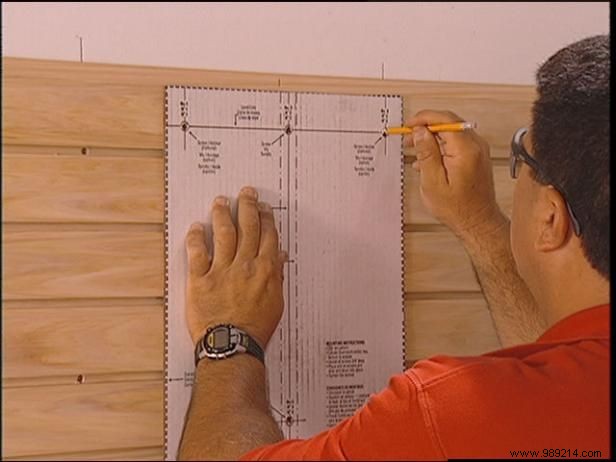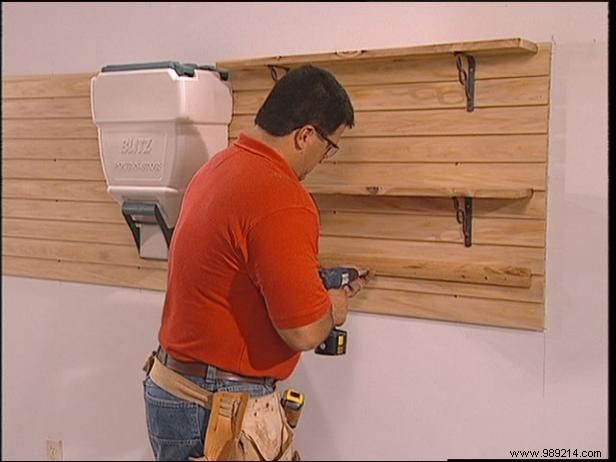First, measure the wall to determine the space available. In this example, an 8' bench can be built with approximately 8" of space left on both ends. The height of the bench is marked 35" tall. An additional 7" is measured and marked from the bench area to indicate the bottom of the slatwall board being installed. Use the level to mark the exact board layout, creating an 8' rectangle on the wall.
Use a stud finder to locate wall studs. Use the level to mark vertical lines from top to bottom, following the location of the bolt. Extend the mark at the top beyond the top of the outline so the lines can be seen after the top piece is installed.

To install the backboard, drive a couple of nails into the first board that the first board will rest on. Next, use a drill to countersink the screw holes between the slots in the wall board. Next, attach the first board with 2" wood screws, making sure the screws are flush with the wall studs.
Set the second board in place, lining up the tongue and groove that hold the boards together. Secure with screws. Continue the process until the wall is assembled.


Locate the center of the board and mark. Align the template that came with the dispenser with the mark on the board (Image 1). Then drill the holes and install the screws. Allow enough each screw to extend as needed to suspend the dispenser.
Slide the dispenser into position (Image 2), then tighten the interior screws. Test the dispenser by filling with potting soil.


First, measure the available space to the right of the potting soil dispenser and determine the length of the shelves (here, the shelves will be 38" long).
Then measure 8" from both ends and use a speed square to mark the location of the shelf brackets. Hold the brackets in place and mark the first screw (Image 1).
Pre-drill the fastener and fix the top screw. Repeat for the bottom bracket bolt, then go back and hand-tighten the first bolt (Image 2). Repeat the same process for another support.
Measure and mark the location of the second shelf. Use a level to align the second set of supports with the first set. Follow the same process for placing the supports as for the first set.



Use the table saw to square the ends of 1 x 6 boards, then measure and mark the length needed for the shelves. Cut both boards at once, then place the boards on the supports (Image 1). Line up 1-1/4 from the end of the board. Make sure the front of the shelf is flush with the ends of the brackets, then attach with wood screws (Image 2).
Next, create a bottom shelf to store flower and vegetable plants. First, secure a 1 x 12 cedar by clamping, then mark the board at 38" (Image 3). Cut to length with a circular saw. Use the table saw to rip a 45 degree angle about 1" wide ( Image 4).
Rip 1 x 6 to the same length as the shelf, but about 2" wide. This piece will act as a brace and connection point where the angled shelf meets the back board. Use a level to mark the location bottom shelf.



Measure 4-3/4" and mark the location of the brace. Use a nail gun to secure the brace (Image 1). Use 2" wood screws to attach to the board (Image 2).
Add metal dowels designed for use with slatwall to add support to the sloped shelf. Place the shelf in the bracket, align and nail in place with the nail driver (Image 3). Pre-drill the area above the brace and use wood screws to secure.